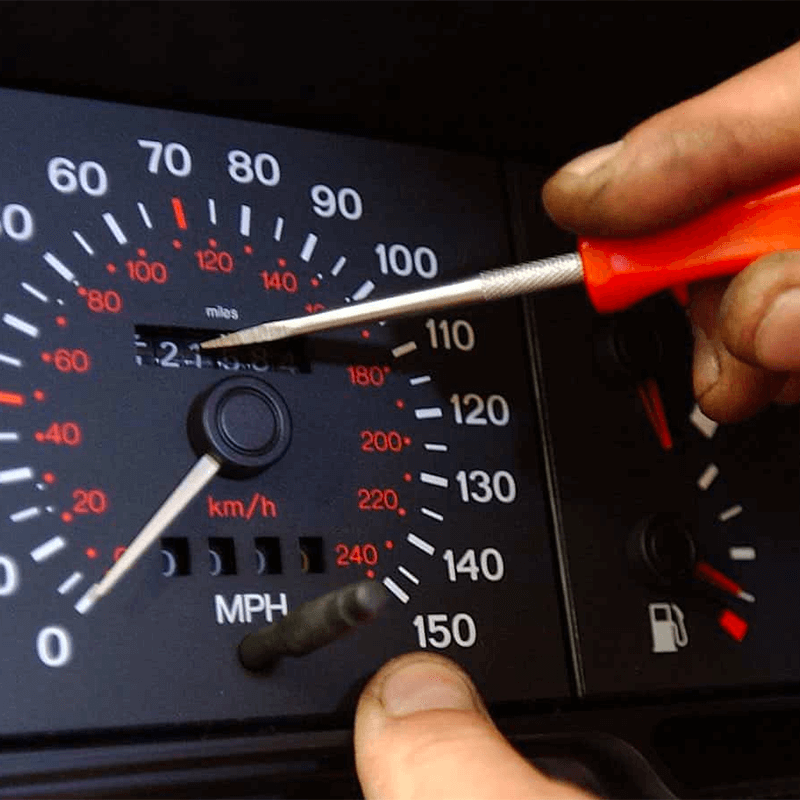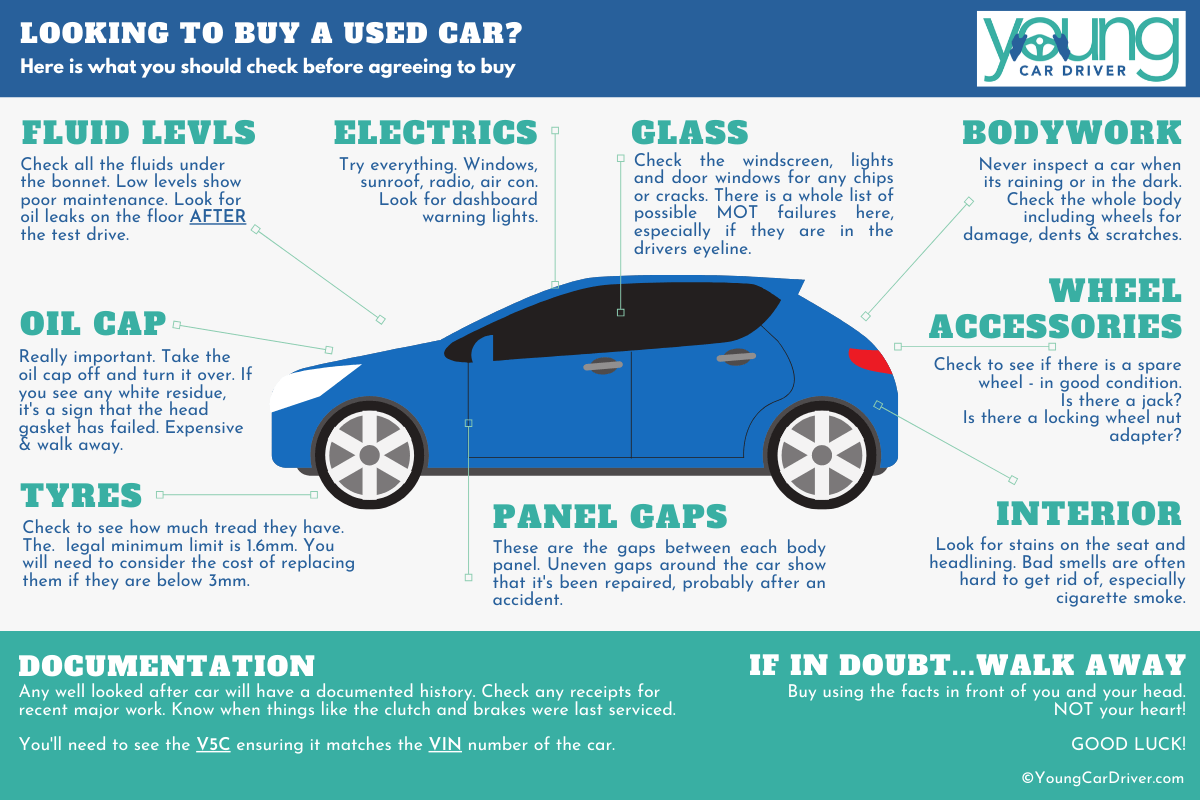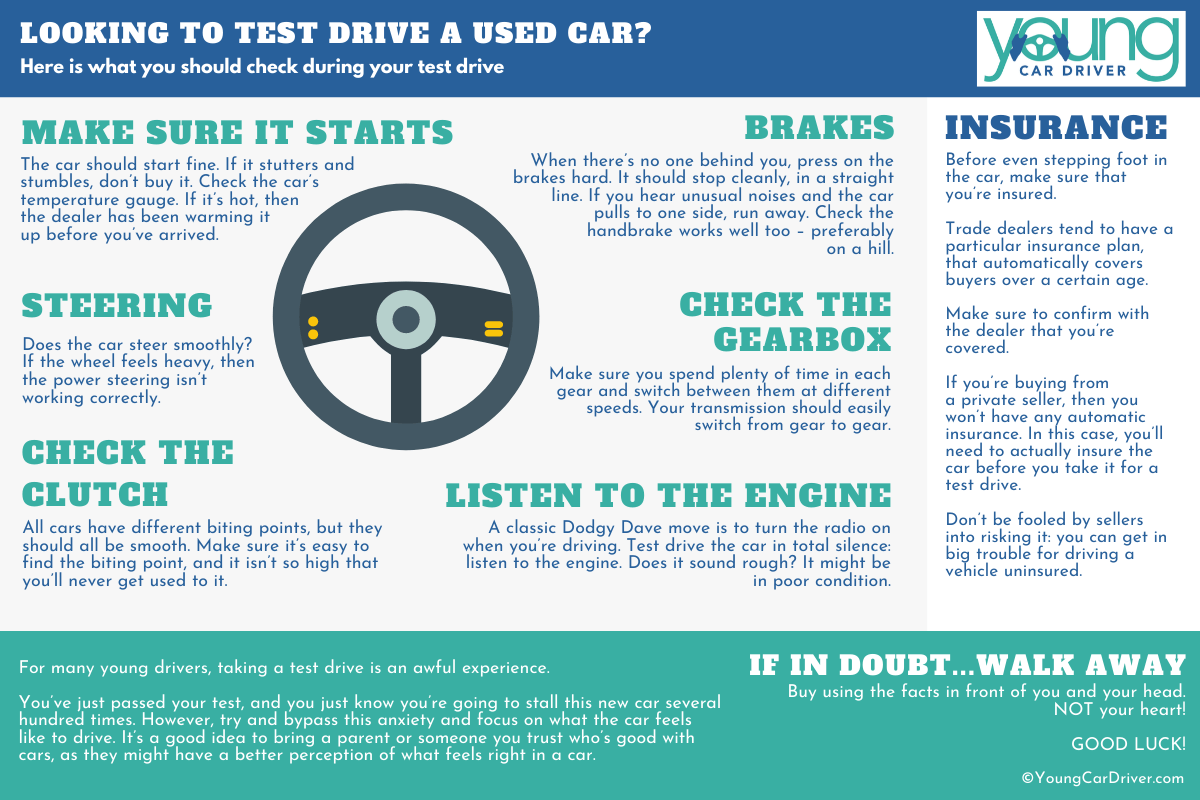Checklist for buying a used car - Definitive
The definitive checklist when buying a used car! Answer the age-old question: is it a good car?
Finding the right car can be tricky – take our checklist when buying a used car
As a young person, a car is likely to be the biggest purchase you’ll make for the next few years (unless you somehow get a mortgage before you’re 30… good luck with that!)
Ask your family members, and you’re guaranteed to hear a few too many horror stories about buying a bad car.
When you’re inexperienced, or a first-time driver, it can seem impossible to figure out whether the car is actually a good buy.
Worry not. We’ve designed this definitive checklist for buying a used car and answer the age-old question: is it a good car?
We’re going to start by talking about things you should check before you see the car, and finish up with what to do when you go to see the car.
Make sure the price is right
If you’re lucky, you’ll hear of a close friend or relative selling a used car. You know the person, you know they wouldn’t lie to you, and you know that they’ll ask for a fair price!
Unfortunately, for most, this situation rarely happens. In all likelihood, you’ll have to go into a dealer or look online for cars.
Either way, before you do anything else, check the price of the car. The fastest way to remove a car from your “maybe” list and into the “no thanks” pile, is to figure out if the price is right.
It’s straightforward to do:
- 1. Find out the number on the cars registration plate, and the mileage it’s driven.
- 2. Use a valuation tool, like this AutoTrader one. Select the ‘buying’ option (instead of selling).
- 3. Look at who is selling the car. Buying from a private person is cheaper than a franchised dealer, for example.
- 4. Compare the valuation price to the list price. If it’s miles-off, run away. A couple of hundred? Check out the Young Car Driver Negotiation page.
Don’t stick with one dealer
In the automotive world, it doesn’t pay to be loyal. For example, you might see a Ford Fiesta for sale in Arnold Clark, costing £4000. Before going to see the car, do your homework. Check other dealers for comparable cars. Finding a similar vehicle at a lower price gives you a bit of power during negotiation.
A quick way to find comparable cars is to filter on Autotrader this lets you select the manufacturer (Ford), model (Fiesta), year (2013), mileage (40,000), and so on.
You may notice that you find a few private sellers.
These are just everyday people who are wanting to shift their car. These cars will be considerably cheaper than a dealer but carry more risk. For more info, check out our guide on Buying a Car from a Private Seller.


Check the service history
Looking through car ads, you’ll likely see “full” or “partial service history” mentioned. A car service is a regular maintenance on the car to keep it working well, done by a garage.
Every car comes with a service logbook and a recommended timeframe for servicing. For instance, one manufacturer might require you to get a full service every year, or every 10,000 miles. You then take the car to a garage and get your logbook stamped by the garage.
You can also get an ‘interim-service’ completed. However, if you just drive a few miles to work and back, it’s probably not necessary. It doesn’t hurt, though!
Garages also offer a ‘major service’ which checks everything on the car; this can set you back a lot of money and isn’t worth it for most drivers.
In the UK, a full service typically costs around £100-150 for a small car. You might resent having to pay this, but trust us, it’s far better to pay the equivalent of a few pints a month rather than have to deal with car problems.
Service isn’t a legal requirement – only an MOT is a legal requirement). However, you must get your car serviced. For one, it’s essential for your safety. Also, if you’re in a crash that’s caused by your car’s mechanical issues, you could be charged – you’re responsible for making sure your vehicle is roadworthy at all times. Never miss a service!
A car with a full-service history has apparent advantages:
- It’s been taken care of by responsible owners. Major mechanical issues are unlikely to arise if the vehicle is regularly maintained.
- If your car is within warranty, you can get mechanical problems fixed. If you buy a vehicle that has no service history, the manufacturer might void your warranty. Fair enough – the car hasn’t been taken care of as per the manufacturer’s recommendations!
- When you decide to sell the car on in the future, the value of the car will be much higher if it’s got a full-service history.
Hey did you know?
I am text block. Click edit button to change this text. Lorem ipsum dolor sit amet, consectetur adipiscing elit. Ut elit tellus, luctus nec ullamcorper mattis, pulvinar dapibus leo.
Check the MOT history
In a similar vein to service history, you must check the MOT history of a car. In general, the odd failure is relatively standard, but if it’s consistent, it could spell trouble. For example:
Anna is looking at a lovely little Vauxhall Corsa. It’s low mileage, cheap, and most importantly, is a beautiful colour. However, she checks out the MOT history and notices that it’s failed the last 5 MOTs – mostly for worn brakes. She figures that it’s all fixed, as it’s eventually passed, so she buys the car anyway.
What’s the problem here? For one, cars shouldn’t consistently fail MOTs. The reason a vehicle has failed its MOT speaks volumes about how it’s driven. In Anna’s case, the Corsa always required new brake pads. Most likely, a previous owner was a boy-racer, who drove like a maniac. You can bet your bottom dollar that there are other issues with the car too! Avoid.
Checking a cars MOT track record is easy:
- 1. Jump on the GOV.UK website.
- 2. Enter the car’s registration number.
- 3. Hit “check MOT history”.
- 4. You will be able to see every MOT test since the car was purchased. If all you see is PASS, then the car is likely a good’ un. Lots of failures? Tread carefully.
Do a background check on the car
Some dodgy dealers buy cars that have been ‘written-off’ in an accident. These are called ‘Cat C’ cars, which means they’ve been in a serious accident, flood, or a fire. You should avoid these cars at all costs.
You’ll find that many people do sell these cars on, with good intentions. Experienced motor-ists with some mechanical skills could likely buy the Cat C car dirt cheap, and run it well. For a first time driver, though, it’s a terrible idea.
Checking if your car has ever been in an accident or written off is dead easy. Simply use reputable car check, like this one from the RAC. It cost’s around a tenner, but it’s well worth it, It’ll let you know if the car you’re looking at has got a questionable history.

Make sure the mileage hasn’t been clocked
‘Clocking’ a car is changing the reading on the odometer to read fewer miles than the car has actually travelled.
Fortunately, these days it’s pretty easy to avoid ‘clocked’ cars if you’ve got your wits about you.
The steps we mentioned earlier, like checking a car’s MOT and service history, is the easiest way to verify if the mileage is genuine. At each MOT the distance the car has travelled is recorded. If a car was at 50,000 miles on its last MOT and is miraculously now on Gumtree at 25,000 miles? Its clocked.
However, you should still do your due diligence when inspecting the car. If the vehicle’s odometer reads 20,000 miles, and the steering wheel and front-seat are totally wrecked, then it’s likely that something fishy is going on. Use your initiative.
If you’re in doubt, consider a reputable franchised dealer or respected independent dealer, as they carry next to no risk when compared to a private seller.
Seeing the car in person: things to check
It’s time to see the car in person – finally! And can be a little bit nerve-wracking. Car sales-people have a reputation for being a bit pushy, so it’s important to go in with a plan.
Before taking a test drive, here are Eleven things you absolutely must check before you buy a secondhand car:
1. Tyres
Check the condition of the tyres on the car. Tyres are legally required to be 1.6mm in depth. A quick way to measure this is to insert a 20p coin into the main tread grooves. Check the outer band of the 20p coin – if it’s obscured, your tread is above the legal limit. No worries. If you can’t see it, you’re going to need new tyres.
2. Dents/scratches
Take a good look at the paintwork. Always see the car in daylight. Dents and scratches, if you can live with them, can help you get a better price on the vehicle.
3. Windscreen
Check the condition of the glass on the windshield. Look out for chips, as these can develop into cracks and cause you problems in the future. Also, take a quick look at the headlights – they should be clear and without chips or cracks.
4. Electrics
Try everything literally all electrics in the car. Does the radio work? Does it connect to BlueTooth? Is the air-con blowing cold and hot air? Top tip – one particularly naive writer (ahem) once bought a car from a Dodgy Dave without checking the electronic key. He then had to lock and unlock the car using a spare manual key. Check the key – please.
5. Panels
Cars are made up of metal panels, with a tiny bit of space between them. Have a good look at the gaps – if there’s a large space, it could be a sign that the car has been in an accident before. A dead giveaway is if one panel is a slightly different colour to the rest of the vehicle.
6. Fluid Levels
When you own a car, you need to keep a few fluid levels topped up – namely, the oil, brake, and power steering fluid. Check the fluid levels on the car you’re going to see – they should be fully topped up. If not, it’s a warning sign that the vehicle hasn’t been looked after, or that your dealer hasn’t thoroughly inspected the vehicle.
7. Oil Cap
Examine the oil cap. Look underneath it, and you may notice a white substance that looks eerily like mayonnaise (don’t eat it). This is either a sign of condensation or a warning sign that the head gasket might have failed.
8. Interior
How does the car smell? Yes, seriously. If a prolific smoker has owned a car, you’ll find it very hard to get rid of the smell. Make sure that all seats are free from stains and tears. Ideally, your dealer should have the car fully-valeted before you see it. If they don’t, find another dealer.
9. Accessories
Do your research and find if the car should come with a spare wheel. You should be able to find this by doing a quick Google search on the vehicle’s make, model, year, and trim. This information will be on the listing, or available from the dealer. If the car should come with a spare wheel, or perhaps a jack for lifting the vehicle, make sure it’s there when you buy it.
10. V5C
Before you purchase a car, you must check the cars V5C. Also known as a car’s logbook, the document tells you who is the registered keeper of the vehicle. It’s illegal to sell a vehicle without a valid V5C, so make sure you see one before you proceed with the purchase. You can check if the V5C is legit hold up to the light and look for the ‘DVL’ watermark, which is similar to the watermark on a banknote.
11. VIN
A cars Vehicle Identification Number (a VIN) is a 17 digit number that functions as the unique ID of a car. You need to make sure that the VIN on the V5C matches the VIN on the car. On the vast majority of cars, you can find the VIN on the dash-board of the drivers’ side.
Infographic – Checklist for buying a used car
Warning!
Mileage affects value! Even the experienced get caught out indeed 40% of car dealers have at some time bought a car later found out to be clocked.
Source: CAP HPI, 2019
How to test-drive a used car
For many young drivers, taking a test drive is an awful experience. You’ve just passed your test, and you just know you’re going to stall this new car several hundred times.
However, try and bypass this anxiety and focus on what the car feels like to drive. It’s a good idea to bring a parent or someone you trust who’s good with cars, as they might have a better perception of what feels right in a car.
Before even stepping foot in the car, make sure that you’re insured. Trade dealers tend to have a particular insurance plan, that automatically covers buyers over a certain age. Make sure to confirm with the dealer that you’re covered.
If you’re buying from a private seller, then you won’t have any automatic insurance. In this case, you’ll need to actually insure the car before you take it for a test drive. Don’t be fooled by sellers into risking it: you can get in big trouble for driving a vehicle uninsured.
Here are a few things you should be aware of when taking the car for a test drive:
1. Make sure it starts
The car should start fine. If it stutters and stumbles, don’t buy it. Check the car’s temperature gauge. If it’s hot, then the dealer has been warming it up before you’ve arrived. A sign that the car has trouble starting. Ask to start the car from cold, and try turning it on and off after it’s been running a few times.
2. Check the clutch
All cars have different biting points, but they should all be smooth. Make sure it’s easy to find the biting point, and it isn’t so high that you’ll never get used to it. To make sure the clutch is in good condition, try accelerating up a hill at low revs in high gear. If the clutch slips, it’ll likely need replacing soon. Another test to do is to try and accelerate away quickly (when it’s safe to do so). If the clutch stutters, then it’s not in good condition.
3. Steering
Does the car steer smoothly? If the wheel feels heavy, then the power steering isn’t working correctly. Another classic test is to remove hands from the steering wheel (again, on a safe, and flat, road) and see if the car pulls to one side. You want it to drive relatively straight.
4. Brakes
When there’s no one behind you, press on the brakes hard. It should stop cleanly, in a straight line. If you hear unusual noises and the car pulls to one side, run away. Check the handbrake works well too – preferably on a hill.
5. Listen to the engine
A classic Dodgy Dave move is to turn the radio on when you’re driving. Test drive the car in total silence: listen to the engine. Does it sound rough? It might be in poor condition.
6. Check the gearbox
Make sure you spend plenty of time in each gear and switch between them at different speeds. Your transmission should easily switch from gear to gear. If it’s too slippy or hard to get in gear, then it will likely need to be replaced soon. You can do this same check with an automatic also – listen for the gear changes. It should be smooth and without any peculiar noises.
Infographic – What to check when test driving a used car
Summary
Buying a used car requires a lot of research. Failing to do your homework could result in you ending up with a vehicle that will cost you a fortune in repairs. Make sure you read this checklist thoroughly before looking into a specific car.
If you’ve followed our advice and have determined that that car you’re looking at is a good car, think about how you’ll pay for it. If you’re planning on financing a car, check out our article on how Personal Contract Purchase (PCP) works, or perhaps our Hire Purchase (HP) finance guide.


